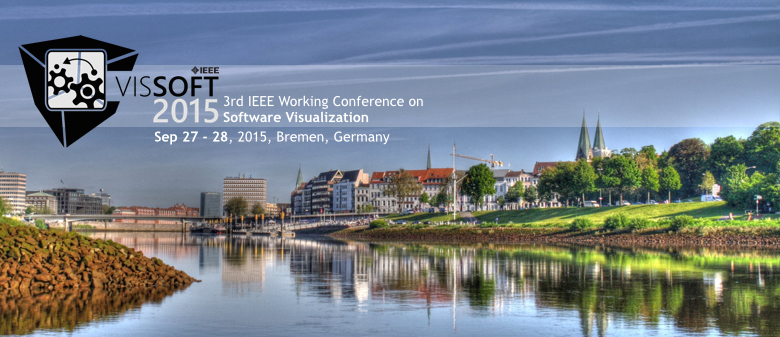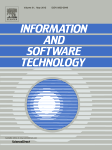Accepted Papers for the Main Research Track
Accepted papers are available on the program page.
Call for Papers
Software visualization is a broad research area encompassing concepts, methods, tools, and techniques that assist in a range of software engineering and software development activities. Covered aspects include the development and evaluation of approaches for visually analyzing software and software systems, including their structure, execution behavior, and evolution.
The VISSOFT IEEE Working Conference on Software Visualization continues the history of the ACM SOFTVIS Symposium on Software Visualization and the IEEE VISSOFT International Workshop on Visualizing Software for Understanding and Analysis. The conference focuses on visualization techniques that target aspects of software maintenance and evolution, program comprehension, reverse engineering, and reengineering, i.e., how visualization helps professionals to understand, analyze, test and evolve software. We aim to gather tool developers, experts, users, and researchers from software engineering, information visualization, computer graphics, and human-computer interaction to discuss theoretical foundations, algorithms, techniques, tools, and applications related to software visualization. We seek technical papers, empirical studies, applications, or case studies and provide a platform for presenting novel research ideas and tools.
Topics of interest include, but are not limited to:
- Innovative visualization and visual analytics techniques for software engineering data, such as,
- source code
- static and dynamic dependencies
- software evolution and repositories
- software documentation
- web services
- protocol, log, and performance data
- parallel techniques
- database schemes
- software security and privacy issues
- workflow and business processes
- Visualization to support program comprehension, software testing, and debugging
- Interaction techniques and algorithms for software visualization
- Visualization-based techniques in computer science and software engineering education
- Integration of software visualization tools and development environments
- Empirical evaluation of software visualization
- Industrial experience on using software visualization
Papers are solicited that present original, unpublished research results and will be rigorously reviewed by an international program committee. In addition to technical papers, VISSOFT features a New Ideas or Emerging Results (NIER) track and a Tool track related to the same list of topics suggested above. All accepted submissions will appear in the conference proceedings and the IEEE Digital Library.
Submission Types
Technical papers (up to 10 pages):
These contributions describe in-depth mature research results in the above-mentioned areas of interest. The submission of a video (up to 5 minutes in length) to accompany the paper is highly encouraged to show interaction possibilities. Technical papers have to be maximum 10 pages long (including bibliography and annexes).
Artifacts: Traditionally, technical research papers are published without including any artifacts (such as tools, data, models, videos, etc.), even though the artifacts may serve as crucial and detailed evidence for the quality of the results that the associated paper offers. Following the effort initiated at ESEC/FSE'11, authors of accepted technical papers at VISSOFT 2015 can have their artifacts evaluated by the program committee.
Awards: VISSOFT 2015 will award distinguished technical papers. Monetary awards will be sponsored by ObjectProfile.com.
Special issue: A selection of the best technical papers will be invited to submit an extended version for a special section of Information and Software Technology (IST) published by Elsevier.
NIER papers (up to 5 pages):
The NIER contributions (New Ideas and Emerging Results) describe work-in-progress and preliminary exciting results. Authors should include open questions and even provocative hypotheses to get early feedback on their research ideas or even support through new research collaborations. NIER papers have to be maximum 5 pages long (including bibliography and annexes).
Tool papers (up to 5 pages):
Tool contributions describe the design or actual utilization of software visualization tools, with a focus on relevant tool construction aspects or the use of the tool for gaining new insights. Authors should be prepared to demonstrate their tool at the conference. The submission may also contain a link to a screencast (video). Tools papers have to be maximum 5 pages long (including bibliography and annexes).
How to Submit
Submissions must be formatted according to the formatting instructions available at the ICSME website and submitted online via the VISSOFT 2015 EasyChair conference management system.
Supplemental material (e.g., video, data, software) that might be helpful for the reviewers can be submitted together with your paper. All material must be included in a single ZIP file. Please note that this supplemental material is independent of the artifact evaluation.
Important Dates
All dates refer to midnight 23:59:59 AoE.
| Main track (technical papers) | NIER and Tool tracks | |
|---|---|---|
| Abstract Submission: | May 4, 2015 | |
| Paper Submission: | May 11, 2015 | June 29, 2015 |
| Author Response Period: | June 8-12, 2015 | |
| Author Notification: | June 18, 2015 | July 31, 2015 |
| Camera-Ready Copies: | August 21, 2015 | August 21, 2015 |
| Artifact Submission for Accepted Papers: | June 24, 2015 | |
| Artifact Notification: | July 31, 2015 | |
| Conference Date: | September 27-28, 2015 | September 27-28, 2015 |



